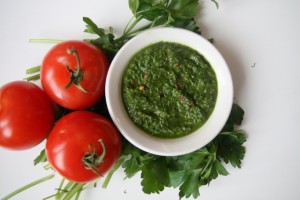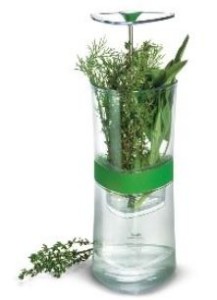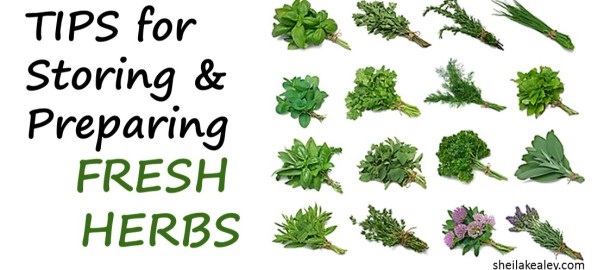 Like most leafy greens, fresh herbs have tremendous nutritional benefits. Their complex flavours perk of the taste of many dishes, so using them often is a great idea. This recipe for chimichurri sauce is a concentrated source of fresh herbs, and is wonderful on many dishes.
Like most leafy greens, fresh herbs have tremendous nutritional benefits. Their complex flavours perk of the taste of many dishes, so using them often is a great idea. This recipe for chimichurri sauce is a concentrated source of fresh herbs, and is wonderful on many dishes.
Having fresh herbs on hand and knowing how to store them will make it easy to cook with them more often.
Here are some tips for storing and preparing fresh herbs . . .
The Best Way to STORE Fresh Herbs
Because the popularity of herbs is increasing, you should be able to find several varieties at your local grocery store. Look for herbs with unwilted leaves and a vibrant appearance. If possible, buy herbs in bunches that still have the root ends (they will stay fresh longer).
A challenge for many cooks is storing herbs: bright and crisp leaves can quickly turn into brown slime if you’re not careful.
Try one of these methods to keep your herbs at their freshest in your refrigerator:
- Store unwashed with the root ends or stem ends in a jar or glass of water with a plastic bag over the leaves (for herbs purchased with root ends this is the best method);
- Wrap unwashed herbs in damp paper towels and put in an open plastic bag;
- Place unwashed herbs in special produce storage bag.
This is a GREAT method for parley or cilantro
 Remove the band from the stems and place unrinsed parsley or cilantro in a wide-mouthed jar (stems down). Replace lid and refrigerate. Periodically pour off any water that appears in jar. Parsley stored in a jar should last at least a couple of weeks. (This is a variation on method #1, above).
Remove the band from the stems and place unrinsed parsley or cilantro in a wide-mouthed jar (stems down). Replace lid and refrigerate. Periodically pour off any water that appears in jar. Parsley stored in a jar should last at least a couple of weeks. (This is a variation on method #1, above).- You can buy a special “herb keeper” for this purpose – I got mine at Manotick’s Peppermill and it works really well!). Here’s a review from Cook’s Illustrated, where they tested various storage methods.
How to PREPARE Fresh Herbs
When you are ready to use them, cut off the root ends (if attached) and wash the herbs gently under cool (not cold) water. Pat dry between paper towels or spin dry in a salad spinner.
- For basil and mint, pull the leaves off the stem. For dill, parsley, and cilantro, simply cut off the stems of an entire bunch as close to the leaves as possible. There’s no need to meticulously tear the leaves from their stems since these stems are relatively tender and won’t be noticed in a batch of minced herbs.
- Chopping with scissors: Place the leaves in a glass measuring cup or small bowl and cut them into tiny pieces with kitchen shears, using short, quick strokes.
- Chopping with a knife: Place fresh herbs in a pile on a cutting board. Using a sharp chef’s knife, hold the tip end down on the board with your fingers and chop with a rocking motion. Keep the herbs in a pile as you chop them into very fine pieces.
Adapted from Food for Thought: Healing Foods to Savor.
More tips, strategies, and techniques to help you
out in the kitchen . . .
- APPLES: Selecting, Storing, and Preparing
- GINGER: How to peel, chop, and grate
- GRAINS: How to cook (UC Berkeley Wellness); Handy Chart! (Popsugar)
- LEMONS & LIMES: How to zest
- MANGOES: How to cut a mango (National Mango Board)
- SQUASH: How to cut and cook
- VEGETABLES: 60+ Healthy Way to Cook Vegetables. Discover healthy ways to cook your favorite vegetables from acorn squash to zucchini (A to Z) using this helful infographic.(UC Berkeley Wellness)
Share This:
